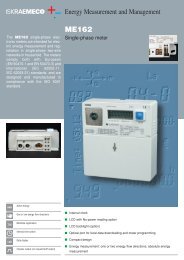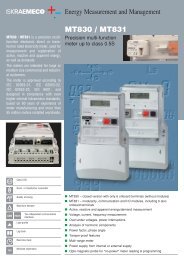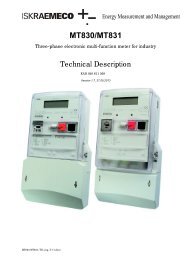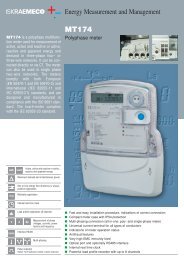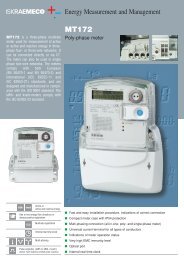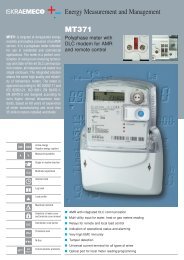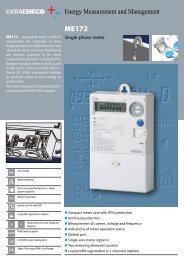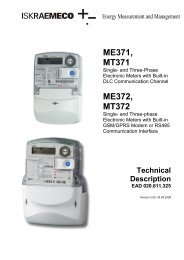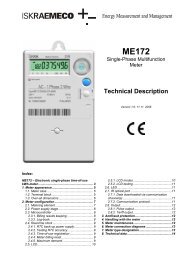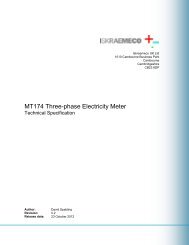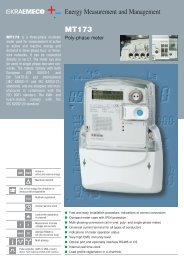ME162 - Technical Description - Iskraemeco UK
ME162 - Technical Description - Iskraemeco UK
ME162 - Technical Description - Iskraemeco UK
You also want an ePaper? Increase the reach of your titles
YUMPU automatically turns print PDFs into web optimized ePapers that Google loves.
<strong>ME162</strong> ─ Electronic single-phase kWh-meter<br />
in previous billing periods. The microcontroller also<br />
generates pulses for the LED and pulse output,<br />
drives the LCD and enables two-way communication<br />
via the optical port and CS interface (if it is built-in).<br />
All measured data are stored in a non-volatile<br />
memory (EEPROM) and are kept for more than 10<br />
years period without external power supply.<br />
2.3.1. Billing results keeping<br />
The meter keeps billing results (energy values registered<br />
by tariffs and total) for up to last 8 billing periods<br />
(months). A number of billing periods (months) for<br />
which billing results are kept is set in the factory and<br />
can not be changed subsequently. The billing results<br />
are stored in a FIFO memory, so that they are always<br />
available for the last n (n = 1, 2, …8) billing periods<br />
(months), regardless if the meter billing reset was<br />
performed by means of the RTC, via the optical port or<br />
remotely via CS interface. The metering results of the<br />
past billing periods (months) can not be displayed but<br />
can be down-loaded via the optical port or remotely by<br />
means of CS interface (20.mA current loop).<br />
The billing reset can be set to be executed by the<br />
RTC:<br />
• Once a year on a specified date and time<br />
• Every month on specified day in a month and<br />
time<br />
• Every month on a specified day in a week after<br />
specified day in a month and specified time<br />
• Every week on a specified day in a week and<br />
time<br />
• Every day<br />
2.4. Real-time clock<br />
A real-time clock is controlled with a 32.768 kHz<br />
quartz crystal which is digitally trimmed. Its accuracy<br />
is better than requested by the IEC 62054-21<br />
standard for time switches. The RTC involves an<br />
internal calendar that assures information on year,<br />
month, day, day in a week, hour, minute, second and<br />
leap year.<br />
The RTC enables:<br />
• Time-of-use registration,<br />
• Automatic meter billing reset at the end of the<br />
billing period (month)<br />
• Automatic change-over to day-light saving<br />
period and back (winter – summer time).<br />
2.4.1. RTC back-up power supply<br />
An Li-battery is used as the RTC back-up power<br />
supply. It assures 5 years of the RTC operation reserve<br />
and has 15-year lifetime. The lithium battery is<br />
positioned on the meter printed circuit board under<br />
the meter cover.<br />
On request the Li-battery also supports data display<br />
on LCD in a meter no-power state.<br />
2.4.2. Testing RTC accuracy<br />
The RTC accuracy can be tested via the imp/kWh<br />
LED (Fig. 1, item 5) when the meter is in the RTC test<br />
mode. The meter is set in the RTC test mode via the<br />
optical port by means of the <strong>Iskraemeco</strong> Meter-View<br />
software so that a command Clock control is sent to<br />
the meter. When the meter is in the RTC test mode,<br />
the RTC 4096 Hz test frequency is fed to the<br />
imp/kWh LED. The meter will stay in the RTC test<br />
mode approximately 18 hours. Then it will return back<br />
into the meter mode automatically. Other ways to exit<br />
from the RTC test mode are:<br />
• By sending a command to exit RTC test<br />
mode by means of the MeterView software<br />
• By disconnecting a meter from the voltage<br />
supply<br />
2.4.3. Time-of-use registration<br />
The meter is designed as a multi-tariff with maximum<br />
four tariffs. A tariff change-over time is defined with<br />
hour and minute. Minimal time period between<br />
change-over is five minute. The real-time clock enables<br />
complex daily and weekly tariff structures, as well<br />
as a couple of seasons in a year:<br />
• Up to 8 seasons in a year (i.e. 8 weekly tariff<br />
programs)<br />
• Up to 8 daily definitions of the tariff change-over<br />
program<br />
• Up to 10 tariff change-over inside individual daily<br />
tariff programs<br />
• Up to 30 holidays (including those based on a<br />
lunar calendar) in which a special tariff program<br />
is defined<br />
2.5. LCD<br />
The 7-segment LCD has 7 + 1 characters, 8 signal<br />
flags and an energy flow-direction indicator. Large<br />
characters and a wide angle of view, as well as<br />
optional LCD back-light, enable easy data reading.<br />
Fig.8: LCD<br />
The data characters are 8 mm high. For data identification<br />
one character is employed, it is 6 mm high.<br />
Bellow the data characters there are 8 signal flags<br />
that indicate current tariff and different meter status<br />
and alarms. The meaning of signal flags are engraved<br />
on the meter name plate below them.<br />
An indicator of energy flow direction is displayed in<br />
the right bottom corner.<br />
6 of 14



